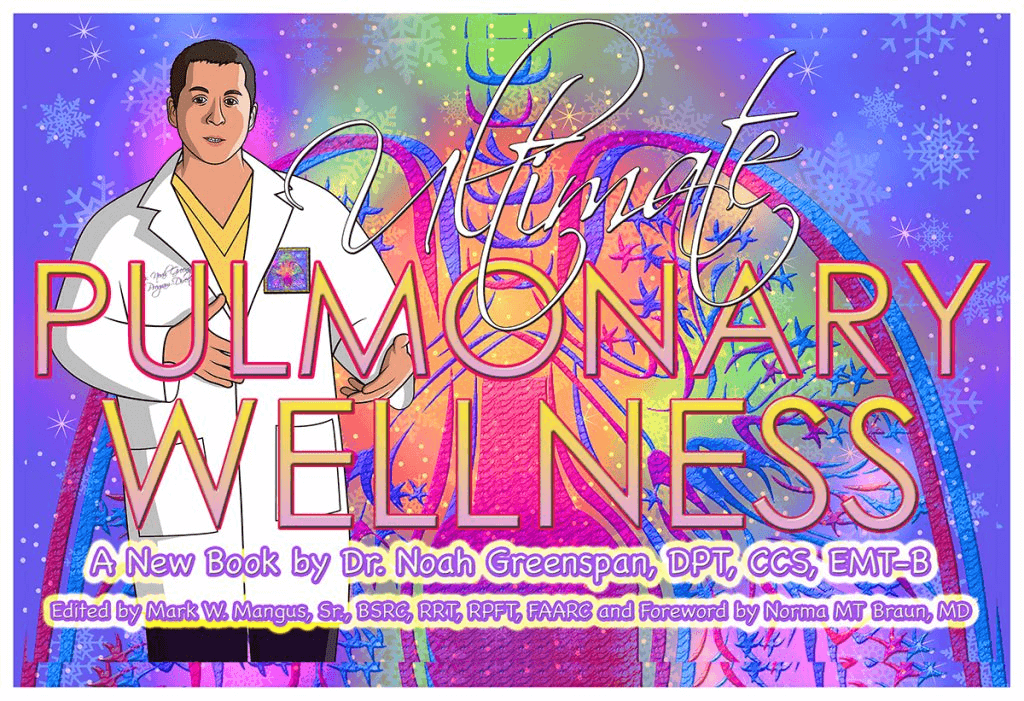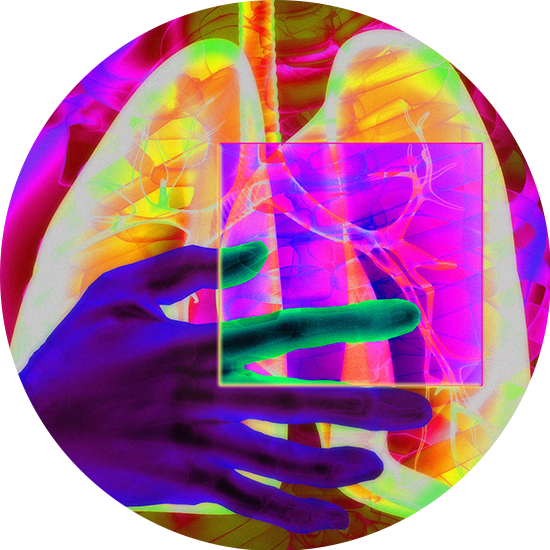
Better Breathing Techniques
Noah Greenspan, PT, DPT, CCS, EMT-B
By a landslide, the chief complaint that I hear most often from patients is shortness of breath. For that reason, we have decided to place this chapter early in the book because we truly believe that these breathing techniques can have a major impact on your life in a relatively short amount of time, giving you greater control over your breathing, reducing your anxiety, and allowing you to participate in more of the activities that you want to; in other words, living your life.
As I’ve already mentioned, for most people, shortness of breath usually begins at high levels of activity such as stair-climbing or walking uphill. To make matters worse, human nature is such that we find every reason under the sun to avoid the activity or activities that cause us shortness of breath. It’s like the old joke where a patient says: “Doc, it hurts when I do this,” and the doctor replies: “well, don’t do that.” Similarly, if you get short of breath when you “do that,” odds are you aren’t going to “do that” very often.
The problem is that once you start eliminating those higher-level activities, all the muscles you use to climb stairs, walk uphill or run for a bus become deconditioned and when muscles become deconditioned, they become less efficient at utilizing oxygen and you then become shorter of breath at lower levels of activity. When it comes to SOB, deconditioning is the number one enemy, and our number one goal is to help you break this dyspnea cycle.
It can be very easy to get caught in the dyspnea cycle of shortness of breath and inactivity, and very difficult to get out. Too often, people avoid the activities that cause them shortness of breath, and for good reason. They’re terrified! However, in many cases, this inactivity can become more debilitating than their original respiratory impairment. For example, someone stops taking the subway because climbing subway stairs makes them short of breath. Then, they find ways to avoid the blocks with inclines, and before they know it, even walking on flat surfaces causes them to gasp for air.
People find all kinds of reasons to stop doing the things that cause them discomfort. For many people, the biggest one is fear. For others, it’s their doctor or other health care professionals telling them to “take it easy.” Still, others are waiting until they feel better before resuming their normal activities or beginning a new program. However, without some form of action or intervention, that day may never come. In fact, the longer you do nothing, the more difficult it will be, the longer it will take and the less likely it will be that you get moving again.
Keep in mind that increased shortness of breath does not necessarily indicate that your lung function has gotten worse. It is completely possible that your breathing difficulty has gotten worse solely due to inactivity or any one of a thousand other explanations other than a decline in pulmonary function. So, don’t throw in the towel just yet.
The good news is that by gaining greater control of your breathing—first, when you are at rest, then during activity, and finally, when you are in distress—your breathing can improve and so can your life.
Here is some more good news. In the same way that your condition can spiral downwards under the wrong conditions, it can also spiral upwards under the right conditions, by implementing positive lifestyle changes. I prefer to use the term “life changes,” because the term “lifestyle changes” sounds like we’ll no longer be “wintering in Miami” or “summering in the Hamptons.” And as I’ve said many times before: “if you want to change your life, you have to change your life.”
In the same way that you have gradually eliminated activities that have become difficult for you, you can gradually begin to build those activities back into your daily routine. Again, I’m not saying it will be easy. Again, it won’t. However, you’re worth the effort of trying, and there are strategies and techniques that can help you get moving again. These include things like taking your medications properly, learning more effective breathing techniques, exercising, eating better, learning how to manage your stress and anxiety, and taking steps to prevent infection.
Before we go any further, let me be clear about one thing. I am not in any way trying to minimize or downplay the role of the respiratory system in shortness of breath. After all, the cardiopulmonary system is my favorite biological system for a reason. I am also not suggesting that by incorporating these breathing techniques, or by switching from white bread to wheat that all your breathing problems will go away overnight. They won’t. What I am saying is that with a little bit of knowledge and effort, you can generate positive changes in your body and your life.
This chapter provides you with practical information and simple instructions on how you can regain control of your breathing. My mentor Dr. Pineda used to say: “Some people wait for things to happen; some people make things happen and some people say, ‘what happened’?” Well, get ready, my friends because we are about to make things happen.
Now, take a deep breath and let’s begin.
The Breathing Techniques: Breaking the Cycle
The first step in breaking the dyspnea cycle is to learn the controlled breathing techniques (CBT) that will help you better manage your SOB, or ideally, prevent it in the first place. These include Pursed Lip Breathing (PLB), Diaphragmatic Breathing (aka abdominal or belly breathing) and Paced Breathing. Although initially, these techniques need to be practiced as separate entities, when I mention controlled breathing techniques or simply, “the breathing”, I am referring to using a combination of all three techniques together.
I will also teach you what we commonly refer to as Recovery from Shortness of Breath. Based upon my experience, the question that patients want answered first and foremost, is what to do when you simply cannot catch your breath. By far, this is the scenario that people fear most and what I believe prevents many people from being able to break the dyspnea cycle. After all, few things in life are scarier than not being able to breathe or as the American Lung Association says: “if you can’t breathe, nothing else matters.”
Again, please remember that no single breathing technique will work best for every person in all situations. Also, don’t expect anything to work immediately or even very quickly. It will take a little time for you to start seeing progress, as well as some personal trial and error. After all, you didn’t get into this hole overnight. You aren’t getting out overnight either. If pressed for an answer, I would estimate that most people start to feel at least slightly better after approximately 3-4 weeks.
Don’t let that discourage you. In fact, I think it should be encouraging. My recommendation would be to try out the techniques—all of them—and practice them. And by practice them, I don’t mean try them once or twice and pray for a miracle. Try each of them under different circumstances and conditions. Give each technique several chances to work so you really have an opportunity to evaluate what works for you and what doesn’t. Trust me. This will be a worthwhile investment of your time and effort. So, please be patient with the techniques and yourself.
Controlled Breathing Techniques
If you have seen any of the UPW webinars or previously participated in a pulmonary rehabilitation program, you may be familiar with some or even all “the breathing” techniques. Again, please understand that while I will describe each technique separately and you will practice each of them individually, you will use all three in concert during exercise and activity. So, when I say, do “the breathing”, I am referring to all three of these techniques used together for maximum effectiveness.
Before we begin, take a moment to observe your “normal” breathing pattern. Are your respirations rapid and shallow or slow and deep? Do you breathe using your abdomen or are you relying on the accessory muscles of your upper chest, shoulders, back and neck? By first observing your current breathing pattern, you will start to become more conscious of which muscles and which breathing techniques are working effectively and where you might need to make some changes.
- Here it is. The moment you’ve all been waiting for—time to discuss the actual techniques that will help you break this vicious cycle of SOB and inactivity.
Pursed–Lip Breathing (Pursed-Lip Exhalation)
Pursed-lip breathing (PLB) can help you prolong exhalation, slow down your breathing, and help keep your airways open—all good things. PLB can be used in any position and regardless of whether you breathe in through your nose or mouth. In fact, as an exercise, I would suggest that you practice performing pursed-lip exhalations, breathing in through both your nose AND your mouth (at different times, of course). For the purposes of this exercise, don’t worry so much about the timing (yet). Instead, just take note of what it feels like to exhale through pursed lips.
As you breathe in, imagine “smelling the flowers” and as you breathe out through pursed lips, imagine “cooling the soup on a spoon.” And please don’t blow your soup clear across the room. Just try to cool it off a little. People often use the suggestion, “blow out the candles.” However, this is the opposite of what we want since the goal of all the controlled breathing techniques will almost always be relaxed, easy breathing.
As you breathe in, you should feel your abdomen rise. As you breathe out, you should feel your abdomen fall, all the while, keeping your upper chest, shoulders, back and neck muscles as quiet (still) and relaxed as possible. Try a few cycles and observe the changes in your body. Is your breathing becoming slower and deeper? Are you becoming more relaxed? If yes, you are doing it right.
To practice pursed-lip exhalations while breathing in through the nose:
- Sit or recline comfortably in a chair.
- Relax your upper chest, shoulders, back and neck muscles.
- Inhale slowly through your nose.
- Exhale slowly through pursed lips.
- Repeat
When breathing in through your mouth, imagine sipping slowly through a straw as you breathe in and cooling your soup as you breathe out. Again, as you breathe in, you should feel your abdomen rise. As you breathe out, you should feel your abdomen fall, all the while, keeping your upper chest, shoulders, back and neck muscles as quiet as possible.
To practice pursed-lip exhalations while breathing in through the mouth:
- Sit or recline comfortably in a chair.
- Relax your upper chest, shoulders, back and neck muscles.
- Inhale slowly through your mouth.
- Exhale slowly through pursed lips.
- Repeat
Diaphragmatic, Abdominal or Belly, Breathing
As I mentioned before, the diaphragm is the primary muscle of inspiration. If you’ve ever watched a baby breathe, you may have noticed that their belly moves in and out with every breath. In other words, they are breathing diaphragmatically. The diaphragm is a big, strong muscle, making diaphragmatic breathing the most efficient and effective way of moving air in and out of the lungs. In fact, we should all breathe diaphragmatically, whether we have a respiratory illness or not.
This allows the diaphragm to function most effectively, giving it the greatest mechanical advantage while trying to quiet the accessory or secondary muscles of ventilation: those of the upper chest, shoulders, back, and neck. To be clear, it is impossible for us to take a breath without contraction of the diaphragm, so technically, all breathing is diaphragmatic breathing. However, since most of us have become most familiar with the use of the term “diaphragmatic breathing,” I will use this term for consistency. As they say, you can’t fight City Hall. Just keep in mind that when we use the term “diaphragmatic breathing,” we are really referring to abdominal or belly breathing.
As we get older, factors such as illness, injury, emotional and even social factors can impact our breathing, causing us to become “diaphragmatically incorrect”. That was a political joke. As an example, stress and anxiety can cause us to breathe less effectively, taking rapid, shallow breaths and using our upper chest muscles, as opposed to using the diaphragm most effectively. Other factors like respiratory muscle weakness, respiratory diseases, obesity or anorexia; and deconditioning can also impair our breathing, making us work harder with each breath. As a result, many of us have developed some very poor breathing habits. If this sounds like you, it will take a little time and effort to unlearn these habits, but it can be done.
To practice diaphragmatic breathing:
- Sit or recline comfortably in a chair.
- Relax your upper chest, shoulders, back and neck muscles.
- Inhale slowly through your nose. As you inhale, your abdomen should rise as your lungs fill up with air, while keeping your upper chest as still as possible.
- Exhale slowly through pursed lips (PLB). As you do this, your abdomen should fall.
- Repeat
Paced Breathing
At this time, we will address the issue of supply and demand by combining the two previously mentioned techniques, pursed lip breathing and diaphragmatic breathing, in a coordinated effort, called Paced Breathing.
As you increase your activity level, your body requires a greater supply of oxygen (air) to meet the greater demand of the activity. Therefore, it will be to your advantage to incorporate breathing techniques that allow for the greatest amount of flow, while at the same time, minimizing airway obstruction and air trapping. Again, I would recommend trying them all to figure out which ones will become your “go to” techniques.
The most used pacing pattern is to exhale for twice as long as you inhale. For example, try breathing in through your nose for a count of two and exhaling through pursed lips for a count of four (or 3:6, or 4:8). Breathing in for a count of one and out for two is usually too short and not often effective for most people although sometimes there’s no alternative. People with restrictive lung diseases like PF often have two issues with this pattern. They may find it difficult to breathe in for 2 or longer and they may find it difficult to maintain a prolonged exhalation.
If you have a restrictive disease, I will still suggest starting with in for 2 and out for 4 (or in for 3 and out for 6 or in for 4 and out for 8). If those don’t work, I would suggest trying to shorten the exhalation so I would try in for 2 out for 3, or in for 3 and out for 5.
To practice paced breathing:
- Sit comfortably on a chair.
- Relax your upper chest, shoulders, back and neck muscles.
- Inhale slowly through your nose for a count of 2.
- Exhale slowly through pursed lips for a count of 4.
- Repeat
As you become more comfortable with these techniques, start to utilize paced breathing during your everyday activities, while trying to keep your focus on both pursed-lip and diaphragmatic breathing. Don’t worry if you don’t get it at first. Learning these strategies is a process and will take some time. To be clear, for most people, this is not a natural breathing pattern so don’t expect it to become automatic. It won’t.
When you use all three techniques together – diaphragmatic, pursed–lip, and paced breathing, you are doing “the breathing,” which I will discuss further in the chapter on activities of daily living (ADL).
Recovery from Shortness of Breath
Finally, finally, let’s discuss a topic called Recovery from Shortness of Breath. Now, please…do not wait until you are in what I refer to as a “Code Red” situation before trying to remember these techniques. In fact, the time to begin this training and practice these techniques is when you are comfortable and relaxed (i.e., now).
Most of you know this feeling all too well. You can’t breathe. Your chest feels tight, and you are suddenly aware of every heartbeat. And as if that’s not enough, panic sets in! I can assure you that panic will not help any situation. In fact, panic will cause you to breathe even faster and shallower, making the situation worse. Sound familiar? This “fight or flight” response can trigger a whole cascade of physiologic responses, few of which will be helpful to you.
Let’s use stair climbing as an example. Sometimes, just the thought of walking up a flight of stairs is enough to increase your anxiety and shortness of breath. As you start to climb, you can feel your breathing becoming more labored and it feels as though your heart is beating out of your chest. You wonder if you might pass out or have a heart attack. Some of you may even think you’re going to die.
By this point, you don’t know who or what is in control. Is it the shortness of breath? Is it the chest tightness? Maybe it’s the anxiety. The only thing you know for sure is that it’s not you. This is it! CODE RED! Is it any wonder that people choose to avoid activities that cause this? So, what can you do about it?
There are specific actions you can take that will help you to prevent, relieve and recover from shortness of breath. The first (and most important) one is to stop whatever you’re doing; second, talk to yourself; third, get into the right position; fourth, start the breathing and fifth, re-assess your situation.
Now, ideally, you would have begun your controlled breathing techniques long before you ever got to this point, but now is not the time for “I told you so.”
These are the steps for recovery from shortness of breath:
- Stop!
First and foremost, stop whatever you’re doing that got you in trouble. If it is walking, stop walking. If it is stair climbing, stop climbing. It is highly unlikely that you will be able to regain control of your breathing while continuing the activity that made you short of breath in the first place. Your immediate goal is to put out the fire and at this moment, your supply of air is not meeting the demand of the activity. Therefore, you need to decrease or eliminate the demand by immediately stopping whatever it is you’re doing at the time.
- Talk to yourself.
I’m not talking about some crazy “One Flew Over the Cuckoo’s Nest” type of conversation or that long string of expletives that might run through your mind at a time like this. Instead, now is the time to remind yourself that you do know what to do and that you have some tools in your arsenal that will help you get out of this jam.
My suggestion of what you might say to remind yourself that you know what to do, would be something original, like “I know what to do.” You can also use “relax,” “I am OK,” “calm down,” or whatever phrase or mantra you find most helpful. And…the good news is that once you finish this chapter, you will know what to do. Then it’s a matter of practicing the techniques and getting better at them so that you can start to nip that snowball effect in the bud or ideally, avoid it altogether.
Don’t get me wrong. Self-talk is not a magic trick that instantly reverses your shortness of breath. Instead, it’s a personal call to action, reminding you that you can help yourself as opposed to being a passive recipient of all the wonderful gifts that living with a pulmonary disease keeps on giving (sarcasm intended). Given the choice, I will always choose to act rather than to wait and see what happens.
This is the mindset that you need to adopt when you start to feel short of breath. Remind yourself that you know what to do. Be present. Be in the moment. Be confident. If not, fake it ‘til you make it. And if that doesn’t work, you might benefit from enrolling in a formal pulmonary rehabilitation program where qualified medical professionals will monitor you and you can develop the skills and confidence you need.
- Assume the Position!
Body position can play a tremendous role in how well or how poorly you breathe. There are certain positions that will give you the greatest chance of catching your breath by allowing your diaphragm and your lungs to work more effectively, while others will make breathing more difficult or impossible, like bending over to tie your shoes. By knowing these positions and how to utilize them to your advantage, you will have a much greater chance of minimizing your shortness of breath.
The first part of the position is to bend over. The second part is to fix your upper extremities. In other words, lean forward on your arms.
If you are standing, there are a couple of different ways you can do this. One is by leaning your back against a wall or other stable surface, bending forward at the waist, and placing your hands on your thighs or knees, putting the weight through your arms.
Another option is to lean forward against a wall, table, or other stable surface, bending forward at the waist, and placing your hands or elbows and forearms on the wall or table, again, putting the weight through your arms.
If you are sitting, spread your legs wide apart; bend forward at the waist, and place your elbows and forearms on your thighs or knees, again, putting the weight through your arms.
These positions are effective because they allow the abdominal contents to drop forward, clearing the way for the diaphragm to contract downward more easily. In doing so, the diaphragm, lungs and entire body have the greatest mechanical advantage for breathing, allowing you to move air in and out most freely and effectively.
- Begin the Controlled Breathing Techniques.
By this point in your “Code Red” situation (after a brief conversation with yourself), you should already have stopped what you were doing and assumed one of the recovery positions. Now, begin the controlled breathing techniques. Breathe in through your nose and out through pursed lips, breathing in for a count of 2 and out for a count of 4 (or whichever count works best for you), until you fully regain control of your breathing.
- Reassess and Adapt.
After you have calmed down and regained control of your breathing, re-assess the situation and if necessary, modify the activity that caused your shortness of breath in the first place. Sometimes this can be as simple as walking more slowly or starting the breathing techniques before you’re in trouble.
To practice recovery from SOB:
- Stop what you are doing.
- Talk to yourself, reminding yourself that you know what to do.
- Assume the position.
- Begin the controlled breathing techniques.
- Reassess and adapt.
And there you have it. That’s “the breathing.” Remember that no single breathing technique will work best for everyone. Therefore, every technique will require some trial and error to figure out which ones are most effective for you. Breathe easy, my friends!
Order Your Book Now!

Purchase Your Signed Copy Today!
- Within the United States: $27.50 including Postage and Handling!
- Outside of the US: $52.00 including Postage and Handling! (Sorry. We know that is more than the cost of the book but we cannot ship for less.)
Subscribe To Our Newsletter For Upcoming Offers
- Be the first to know about new webinars, exclusive offers, and podcasts.
























